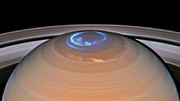Saturn’s northern auroras
Videos
Animation of Saturn’s northern auroras
Closeup of Saturn's auroras
Astronomers using the NASA/ESA Hubble
Space telescope have taken a series of spectacular images featuring the
fluttering auroras at the north pole of Saturn. The observations were
taken in ultraviolet light and the resulting images provide astronomers
with the most comprehensive picture so far of Saturn’s northern aurora.
In 2017, over a period of seven months, the NASA/ESA Hubble Space Telescope took images of auroras above Saturn’s north pole region using the Space Telescope Imaging Spectrograph. The observations were taken before and after the Saturnian northern summer solstice. These conditions provided the best achievable viewing of the northern auroral region for Hubble.
On Earth, auroras are mainly created by particles originally emitted by the Sun in the form of solar wind. When this stream of electrically charged particles gets close to our planet, it interacts with the magnetic field,
which acts as a gigantic shield.
While it protects Earth’s environment
from solar wind particles, it can also trap a small fraction of them.
Particles trapped within the magnetosphere
— the region of space surrounding Earth in which charged particles are
affected by its magnetic field — can be energised and then follow the
magnetic field lines down to the magnetic poles. There, they interact
with oxygen and nitrogen atoms in the upper layers of the atmosphere,
creating the flickering, colourful lights visible in the polar regions
here on Earth [1].
However, these auroras are not unique to Earth. Other planets in our
Solar System have been found to have similar auroras. Among them are the
four gas giants Jupiter, Saturn, Uranus and Neptune.
Because the
atmosphere of each of the four outer planets in the Solar System is —
unlike the Earth — dominated by hydrogen, Saturn’s auroras can only be
seen in ultraviolet wavelengths; a part of the electromagnetic spectrum
which can only be studied from space.
Hubble allowed researchers to monitor the behaviour of the auroras at
Saturn's north pole over an extended period of time. The Hubble
observations were coordinated with the “Grand Finale” of the Cassini spacecraft, when the spacecraft simultaneously probed the auroral regions of Saturn [2]. The Hubble data allowed astronomers to learn more about Saturn’s magnetosphere, which is the largest of any planet in the Solar System other than Jupiter.
The images show a rich variety of emissions with highly variable
localised features. The variability of the auroras is influenced by both
the solar wind and the rapid rotation of Saturn, which lasts only about
11 hours. On top of this, the northern aurora displays two distinct
peaks in brightness — at dawn and just before midnight. The latter peak,
unreported before, seems specific to the interaction of the solar wind
with the magnetosphere at Saturn’s solstice.
The main image presented here is a composite of observations
made of Saturn in early 2018 in the optical and of the auroras on
Saturn’s north pole region, made in 2017, demonstrating the size of the
auroras along with the beautiful colours of Saturn.
Hubble has studied Saturn's auroras in the past. In 2004, it studied the southern auroras shortly after the southern solstice (heic0504) and in 2009 it took advantage of a rare opportunity to record Saturn when its rings were edge-on (heic1003). This allowed Hubble to observe both poles and their auroras simultaneously.
Notes
[1] The auroras here on Earth have different names depending on which
pole they occur at. Aurora Borealis, or the northern lights, is the
name given to auroras around the north pole and Aurora Australis, or the
southern lights, is the name given for auroras around the south pole.
[2] Cassini was a collaboration
between NASA, ESA and the Italian Space Agency. It spent 13 years
orbiting Saturn, gathering information and giving astronomers a great
insight into the inner workings of Saturn. Cassini took more risks at
the end of its mission, travelling through the gap between Saturn and
its rings. No spacecraft had previously done this, and Cassini gathered
spectacular images of Saturn as well as new data for scientists to work
with. On 15 September 2017 Cassini was sent on a controlled crash into
Saturn.
More Information
The Hubble Space Telescope is a project of international cooperation between ESA and NASA.
Image credit: NASA, ESA & L. Lamy
Links
Contacts
Laurent Lamy
Observatoire de Paris
Paris, France
Tel: +33 145 077668
Email: laurent.lamy@obspm.fr
Mathias Jäger
ESA/Hubble, Public Information Officer
Garching, Germany
Tel: +49 176 62397500
Email: mjaeger@partner.eso.org
Source: ESA/HUBBLE/News


























